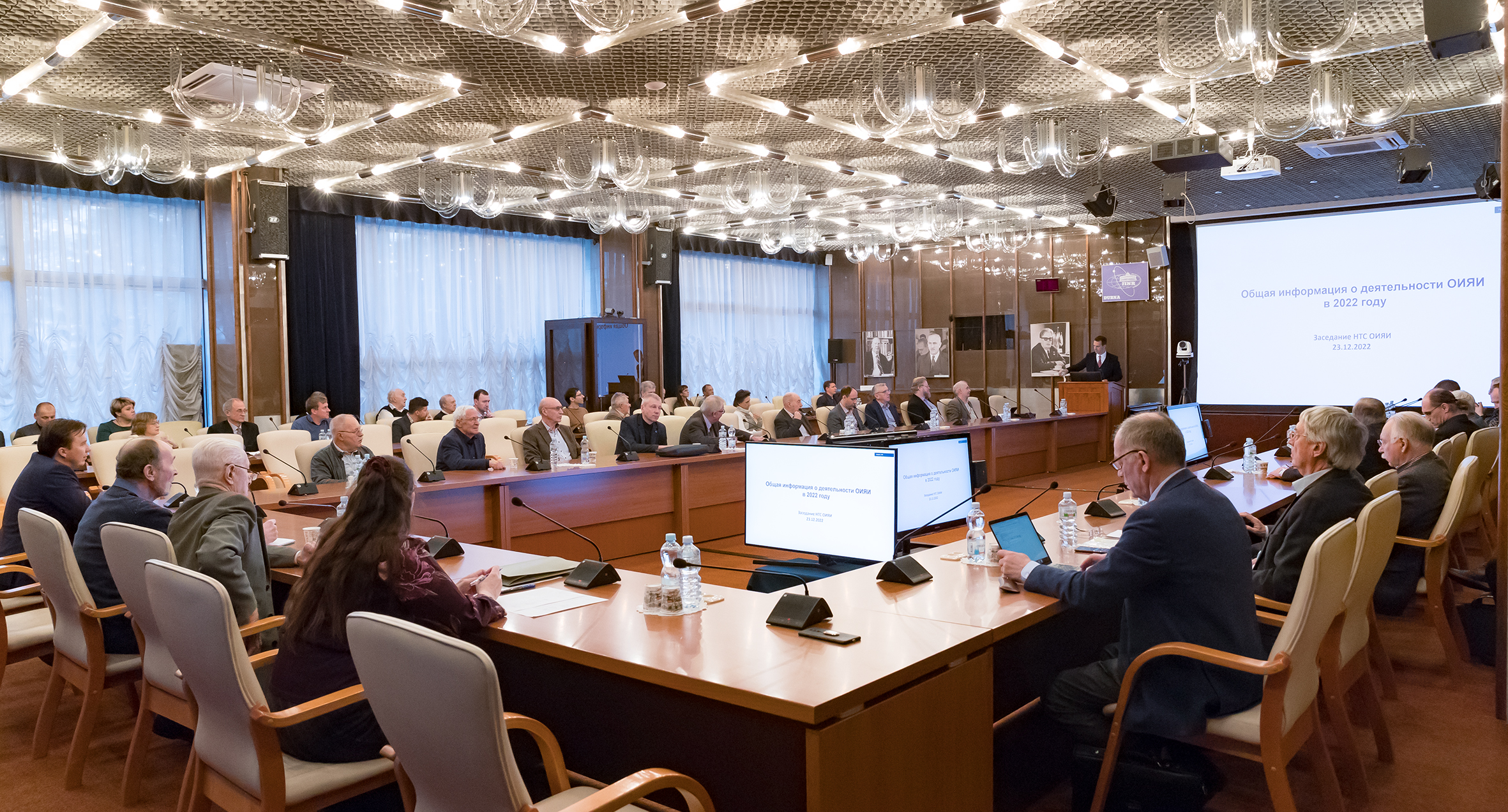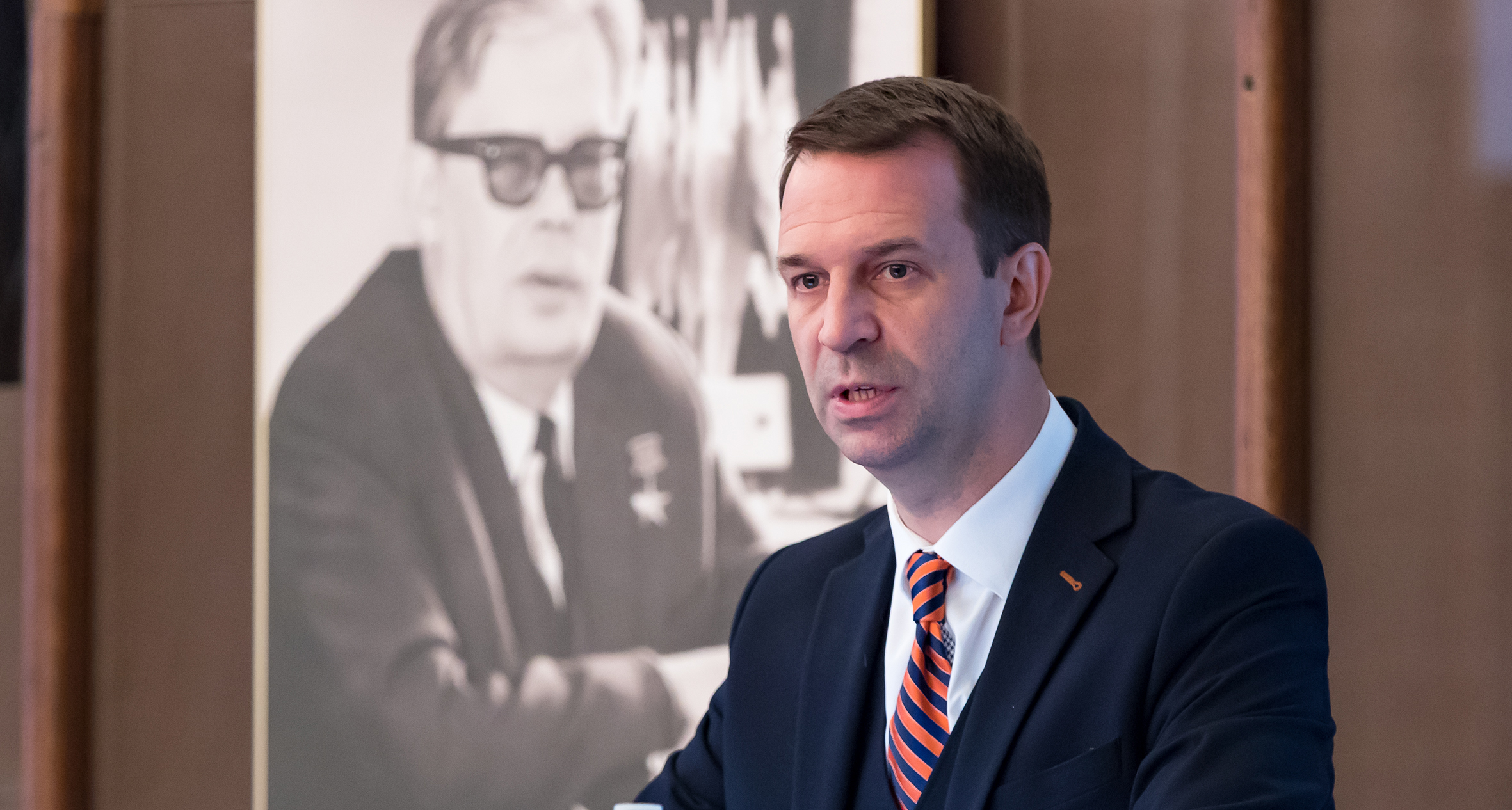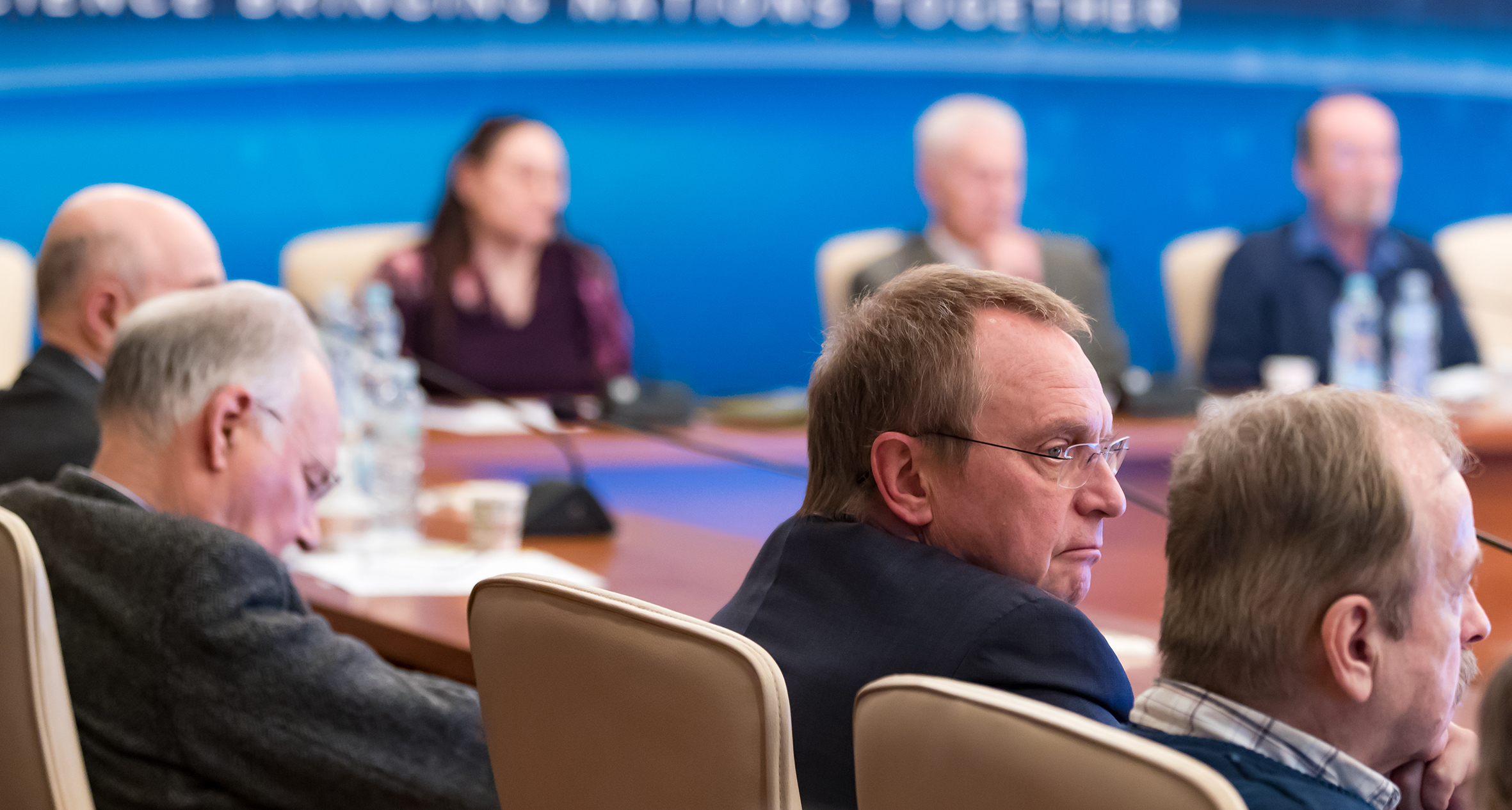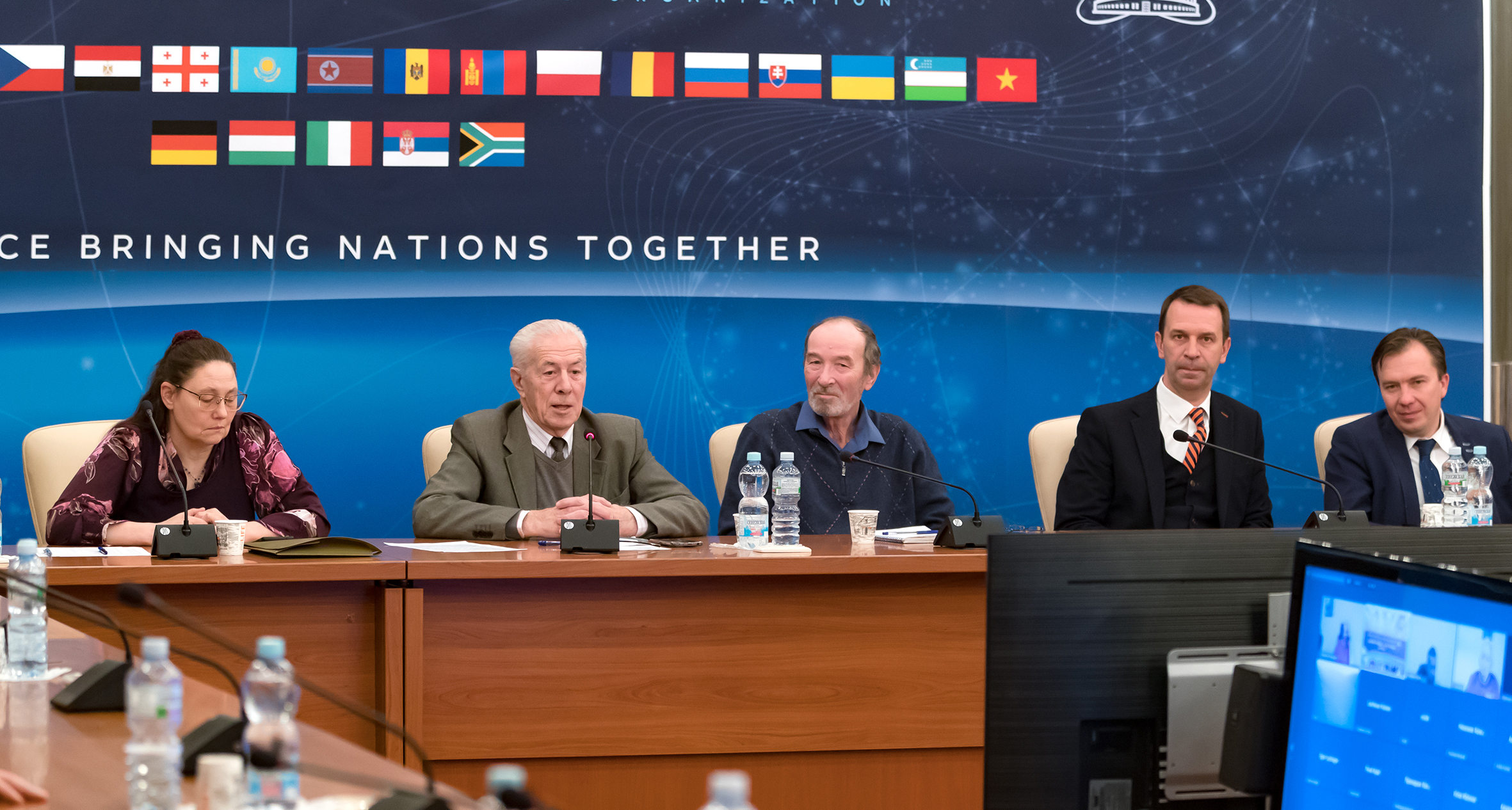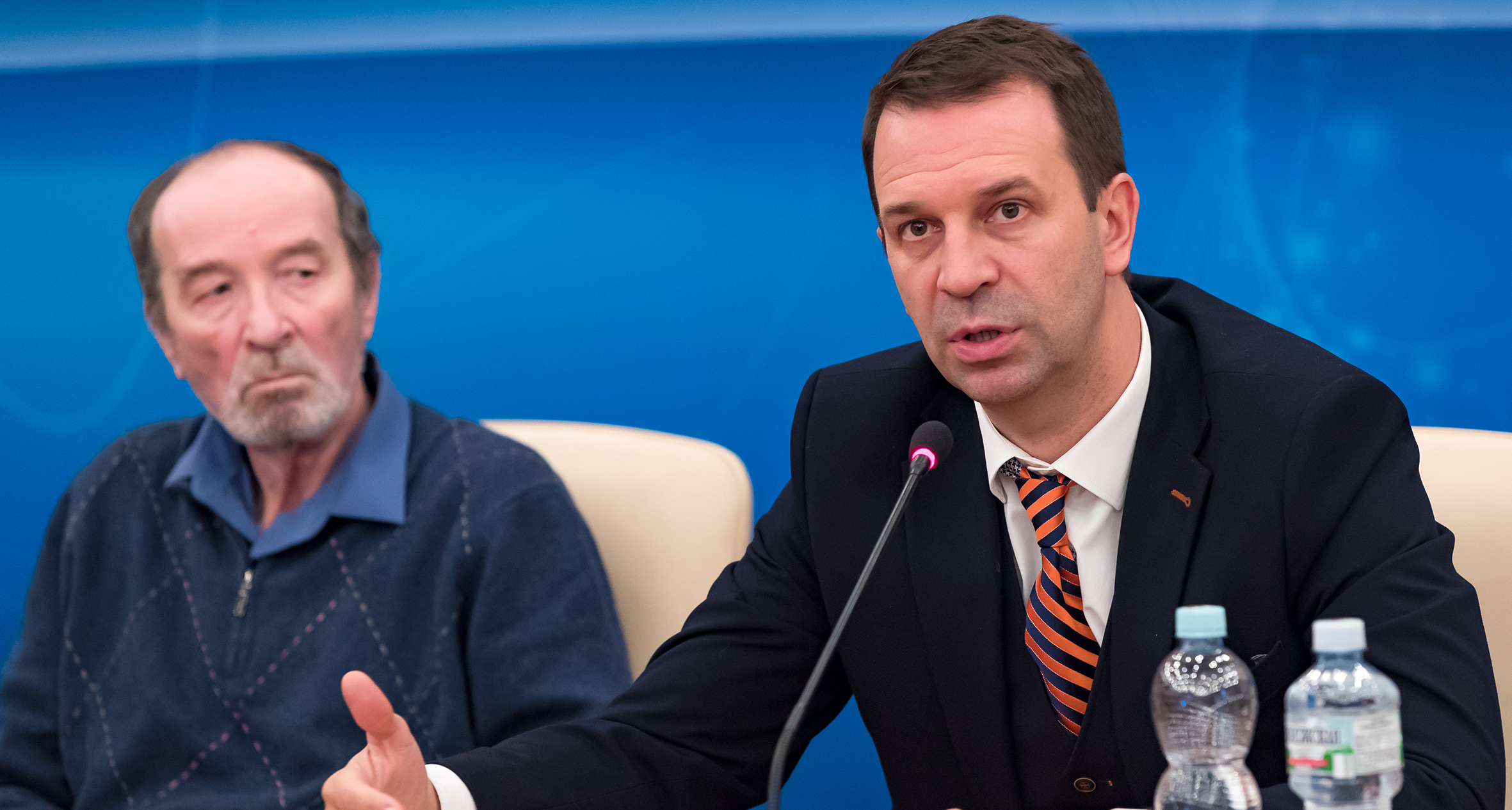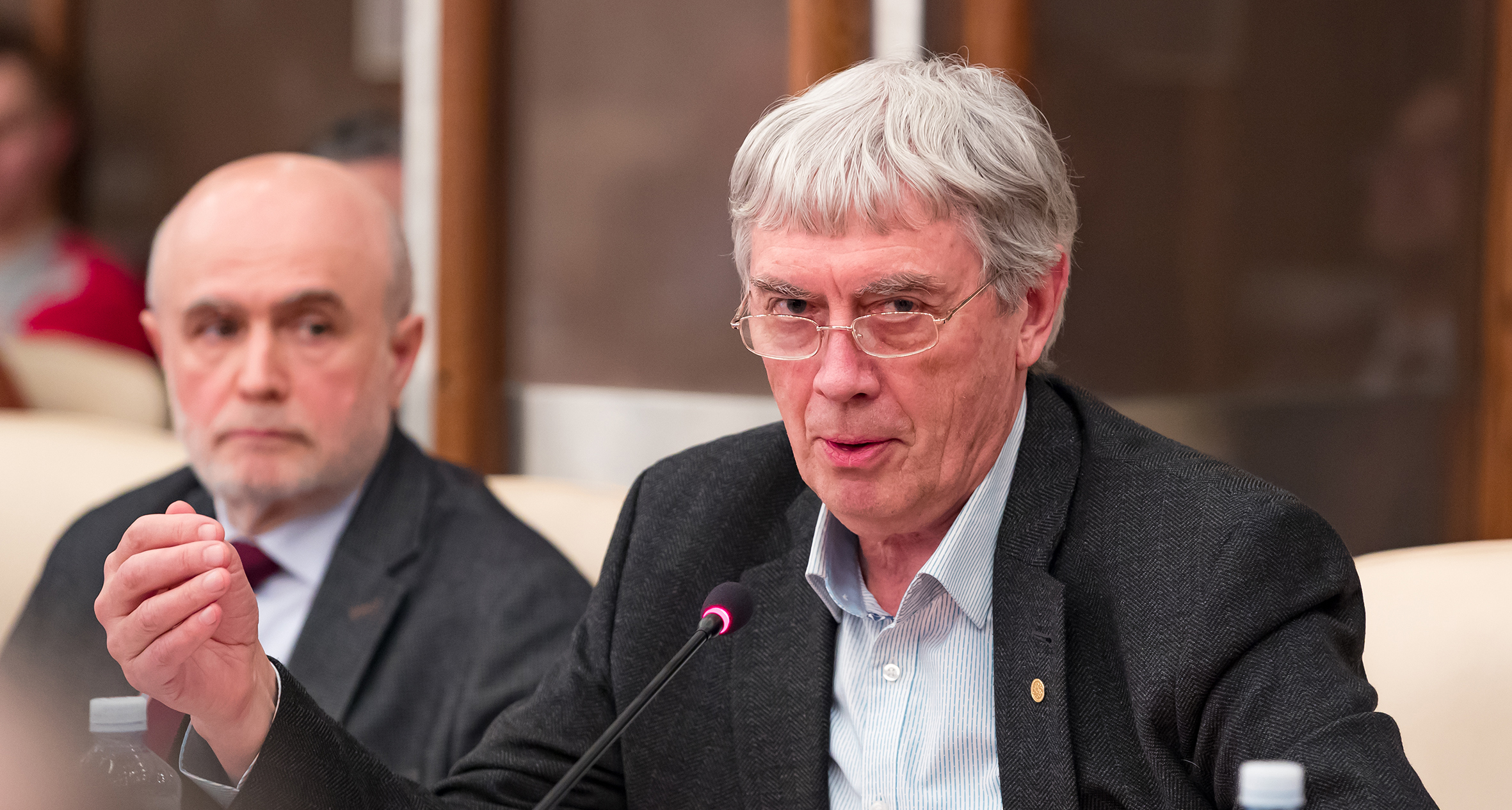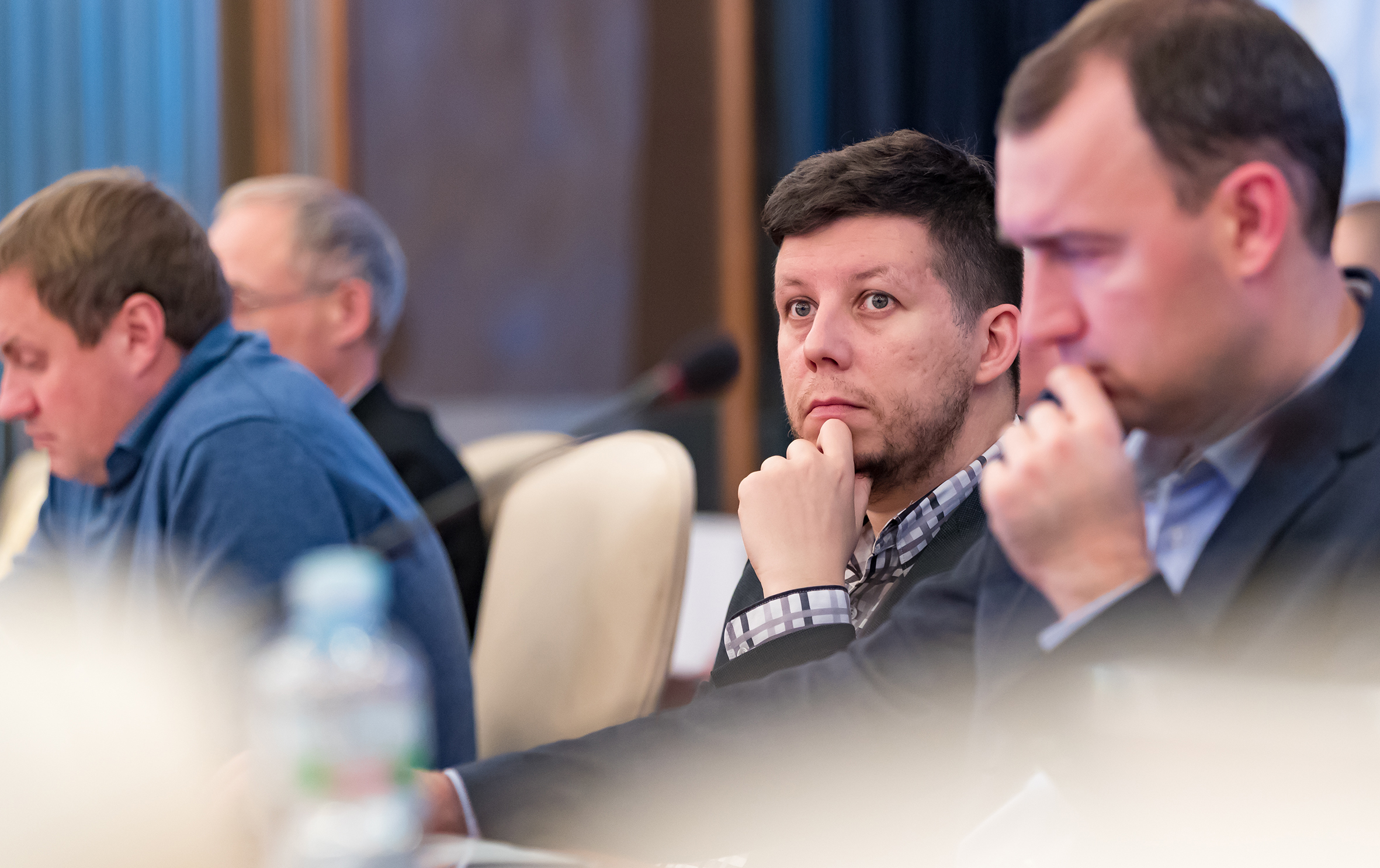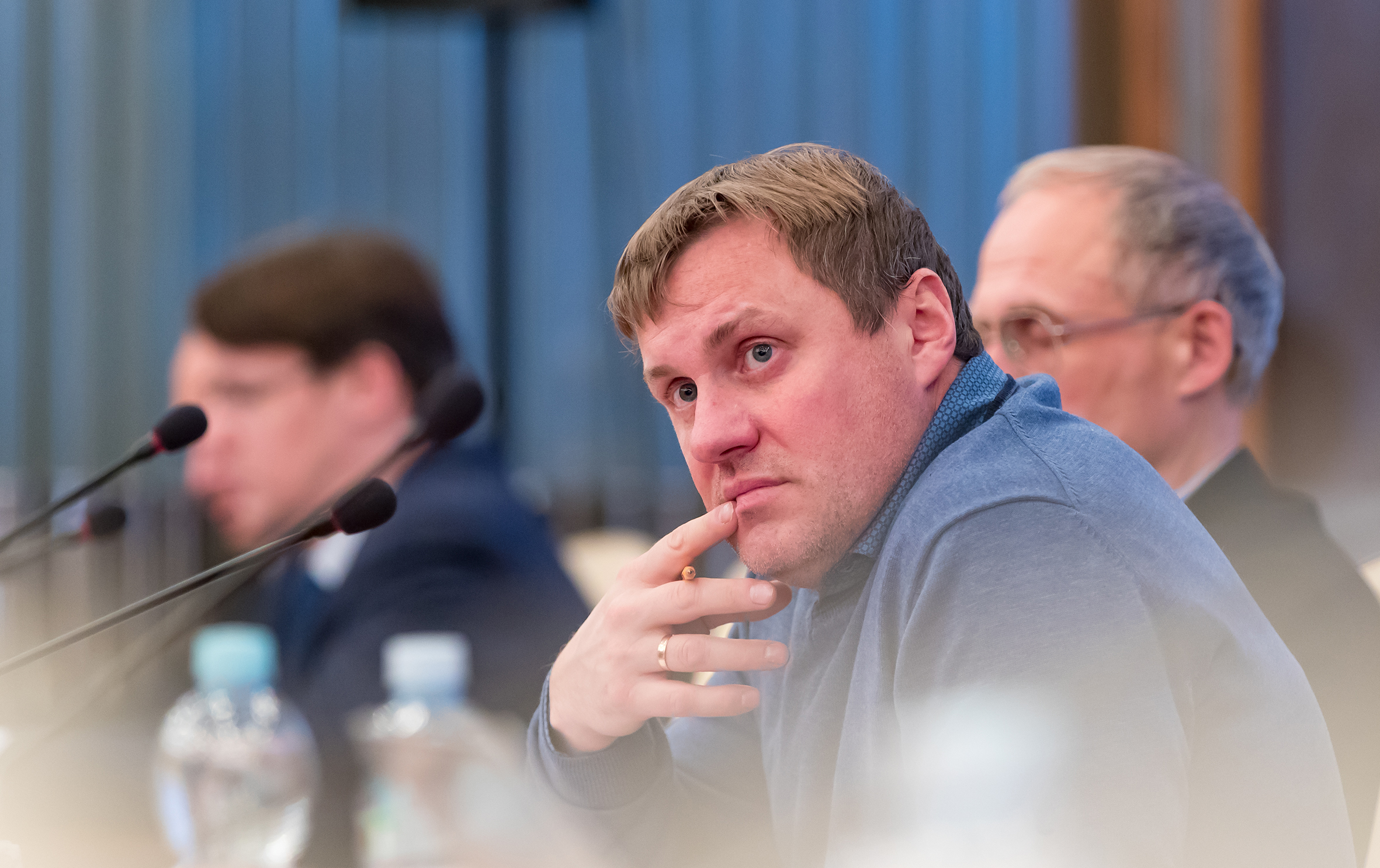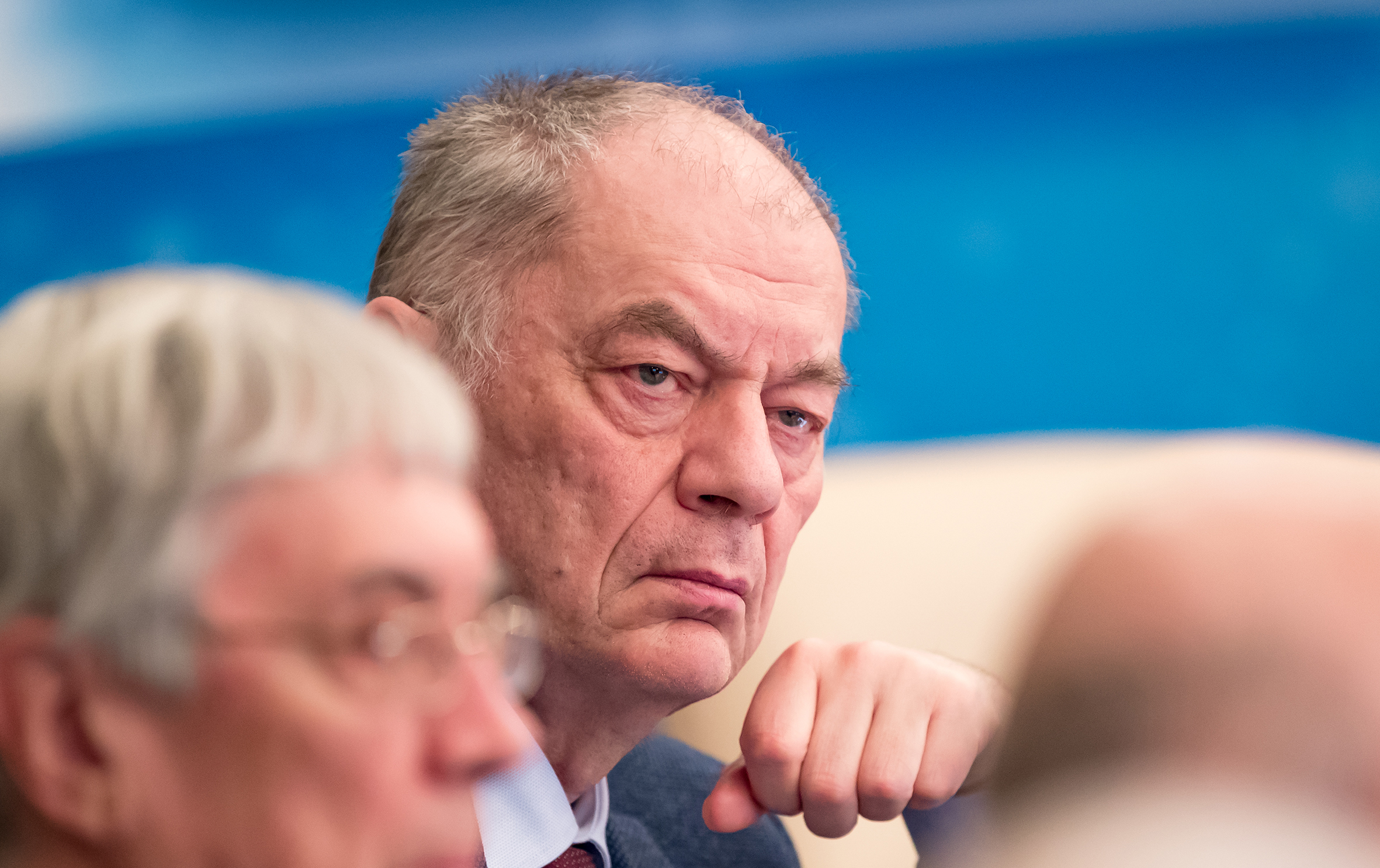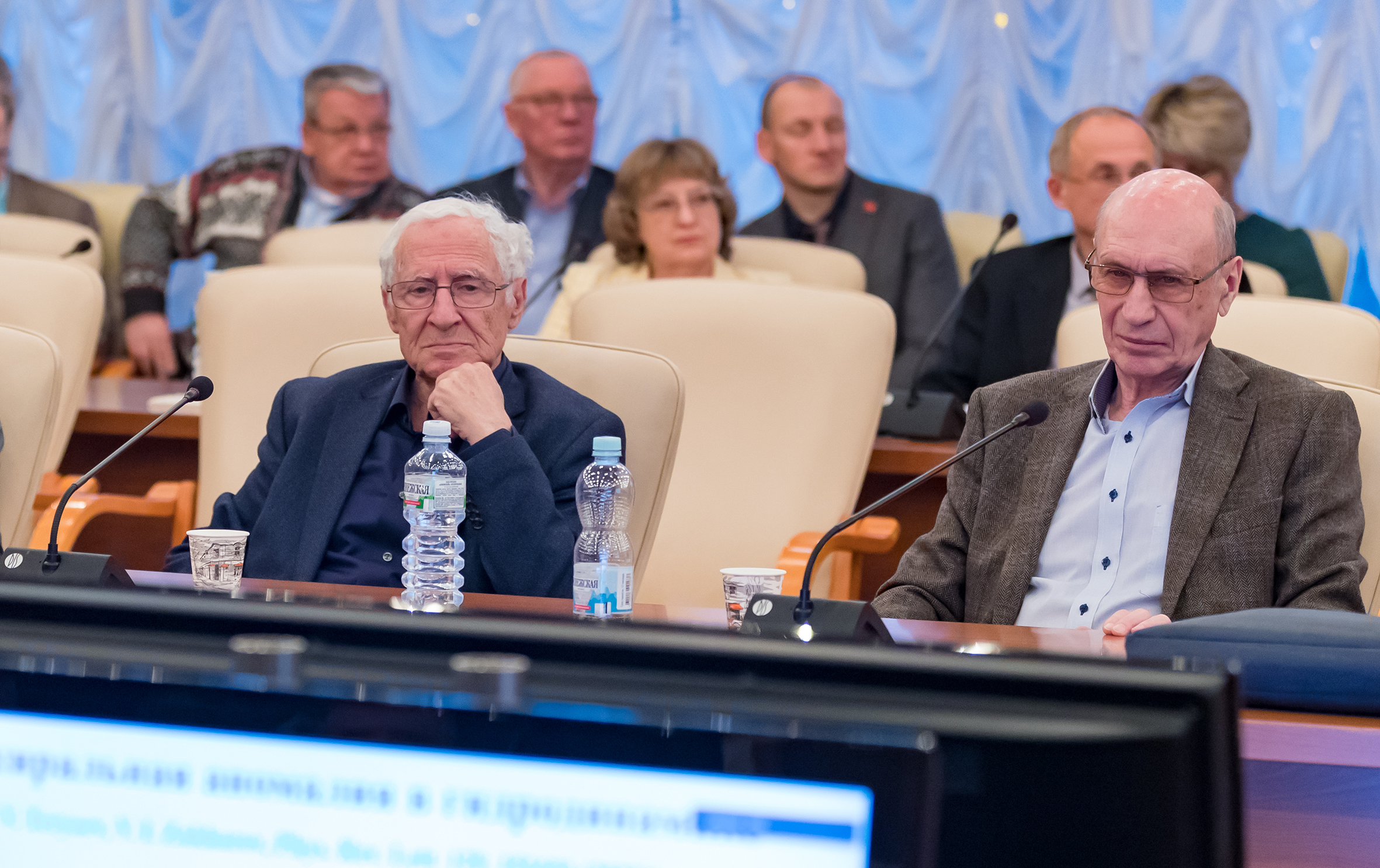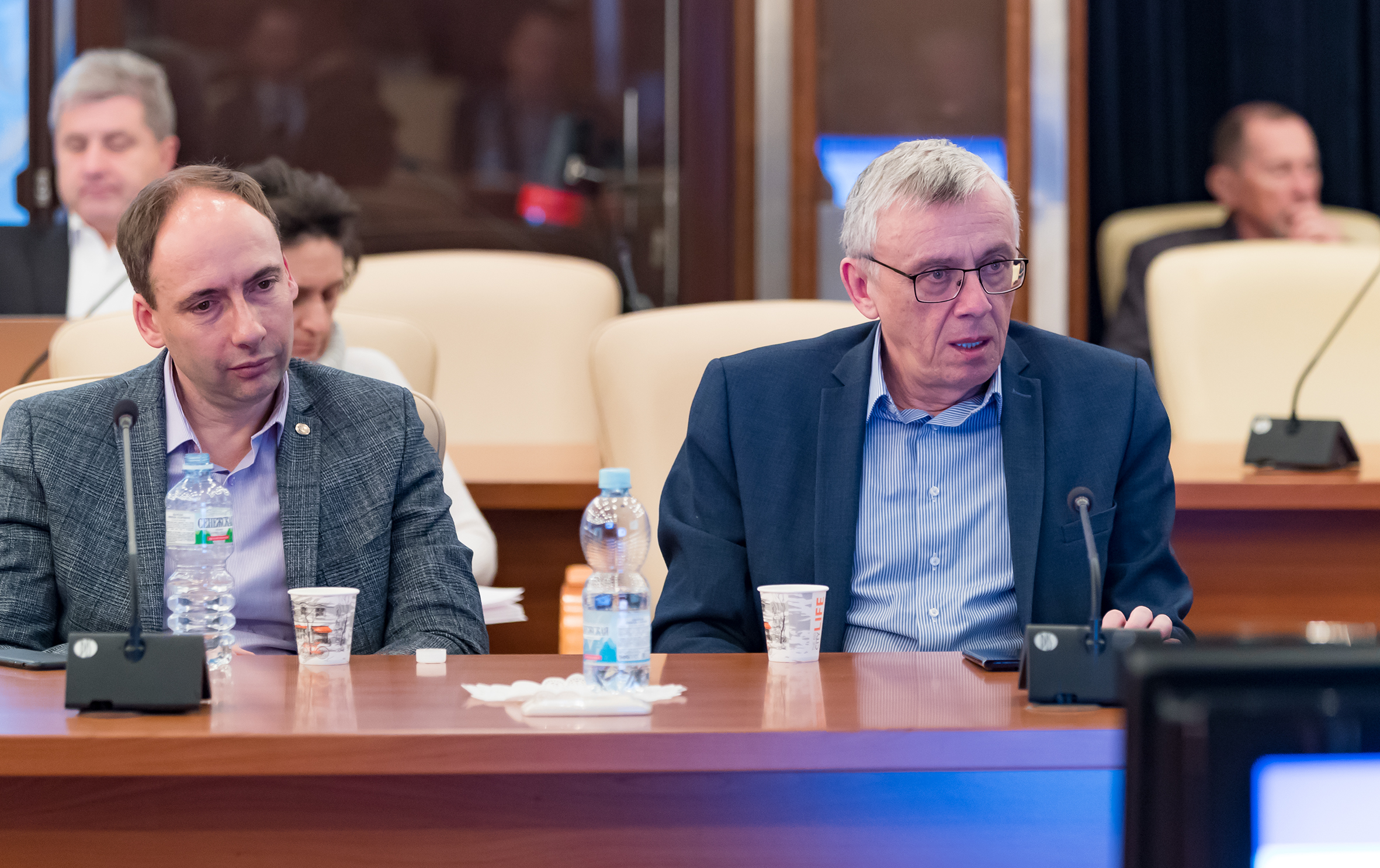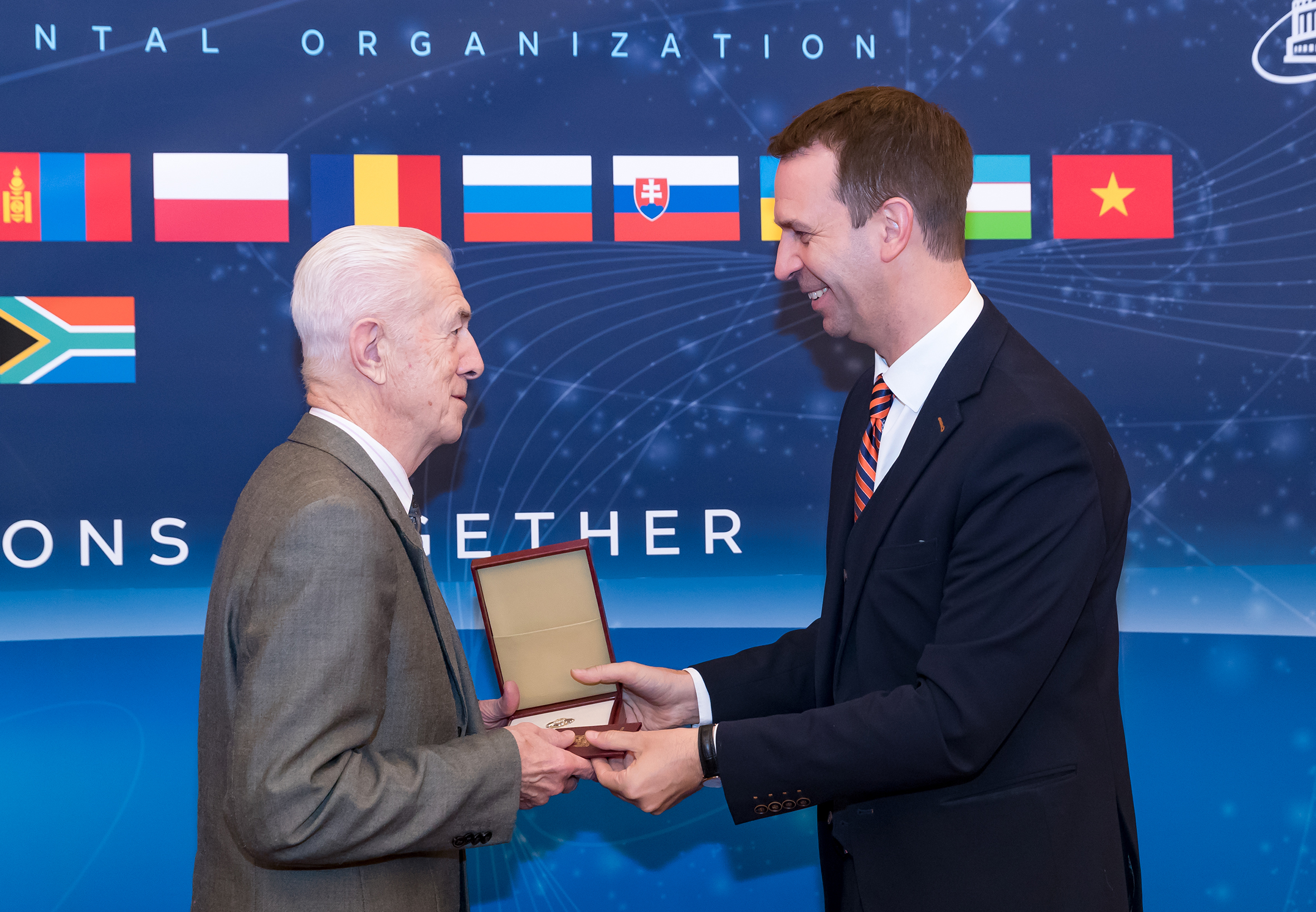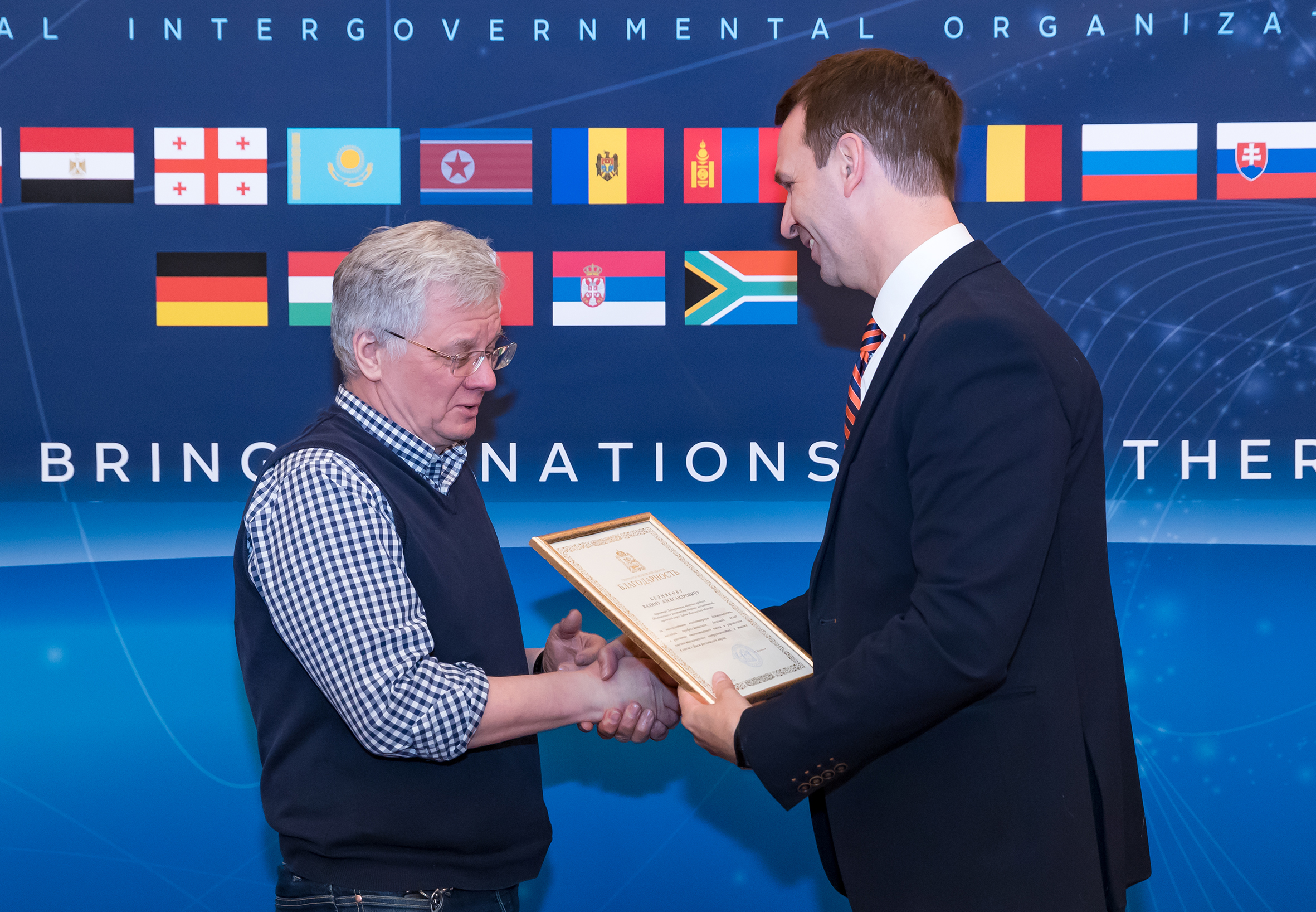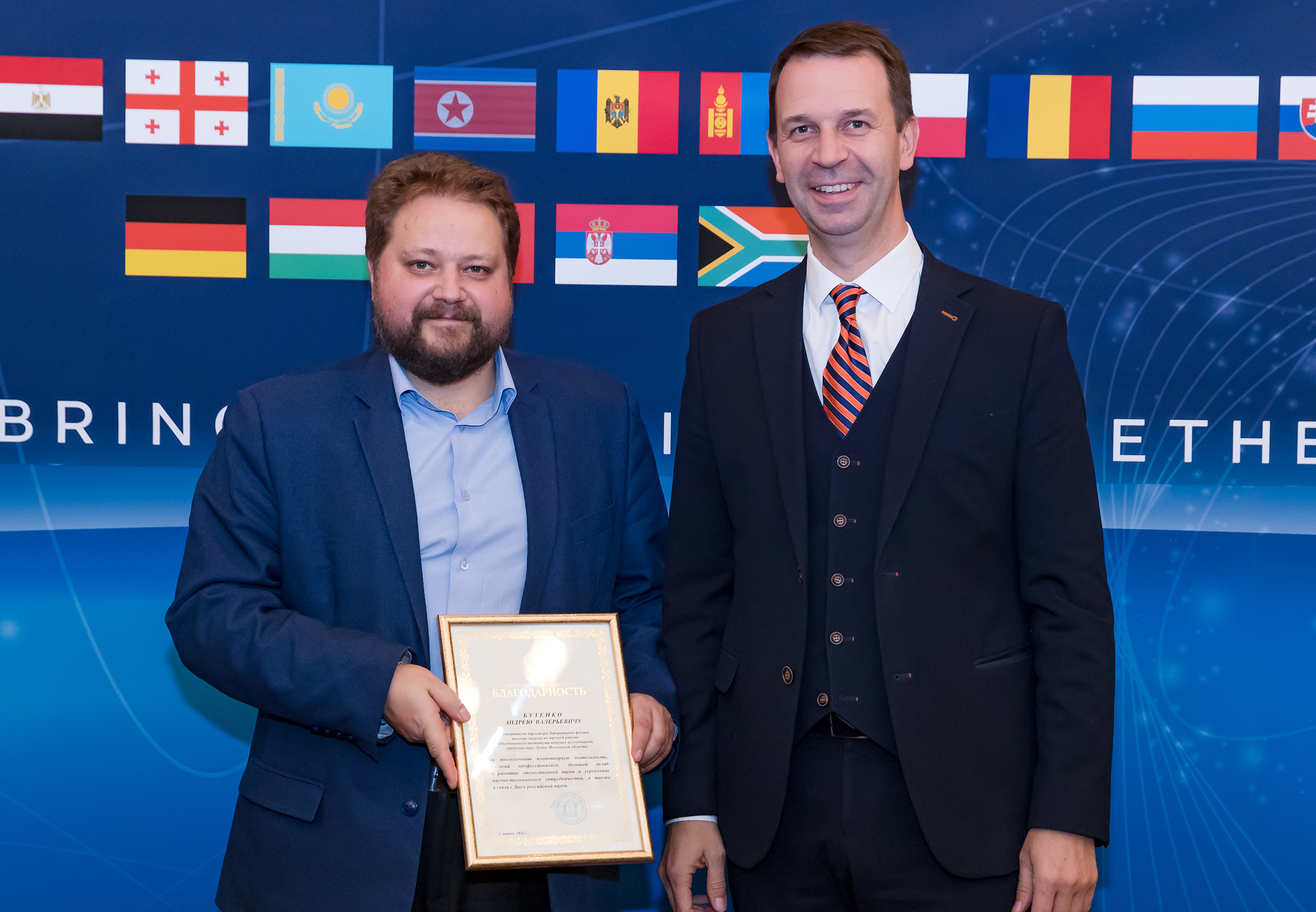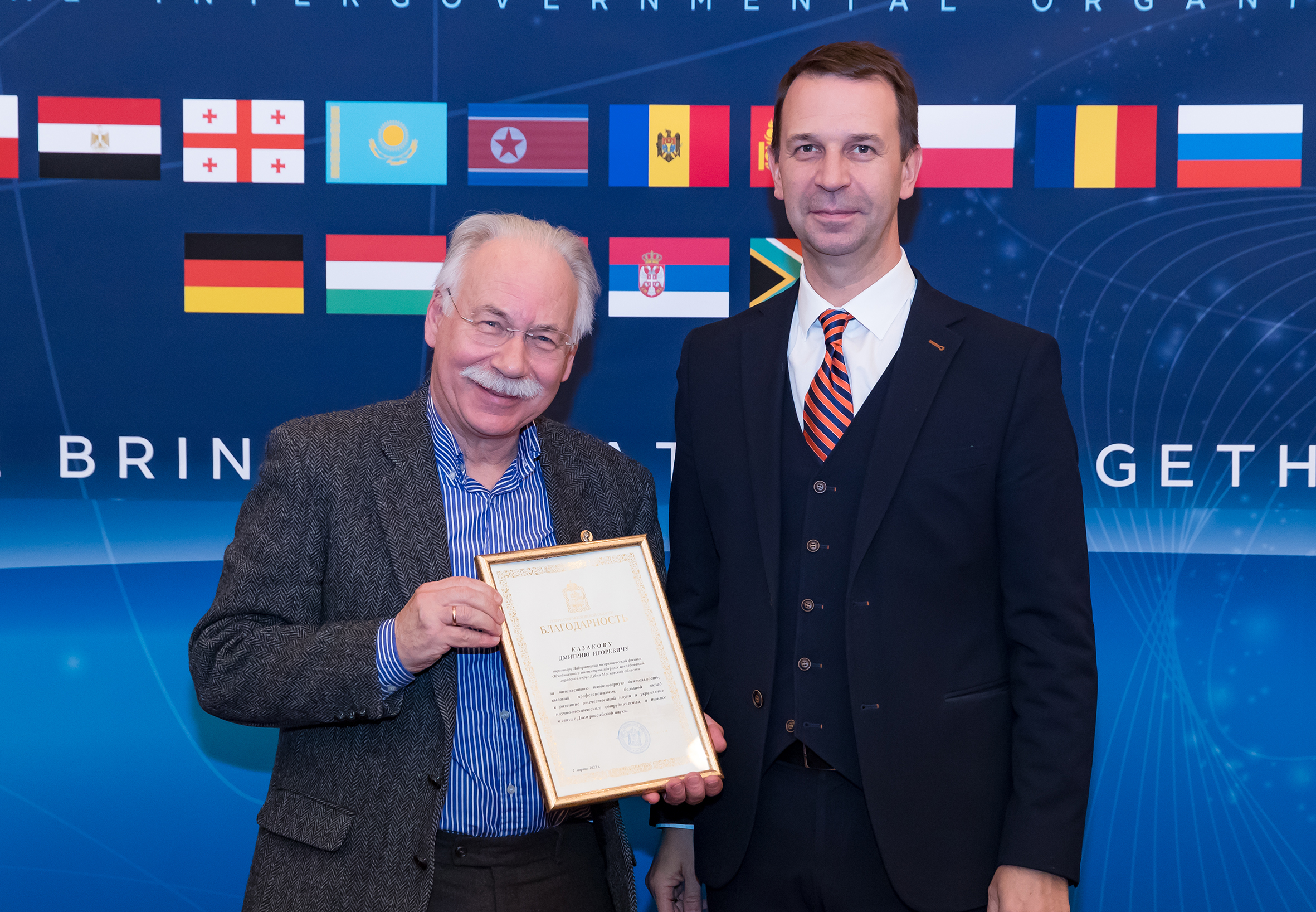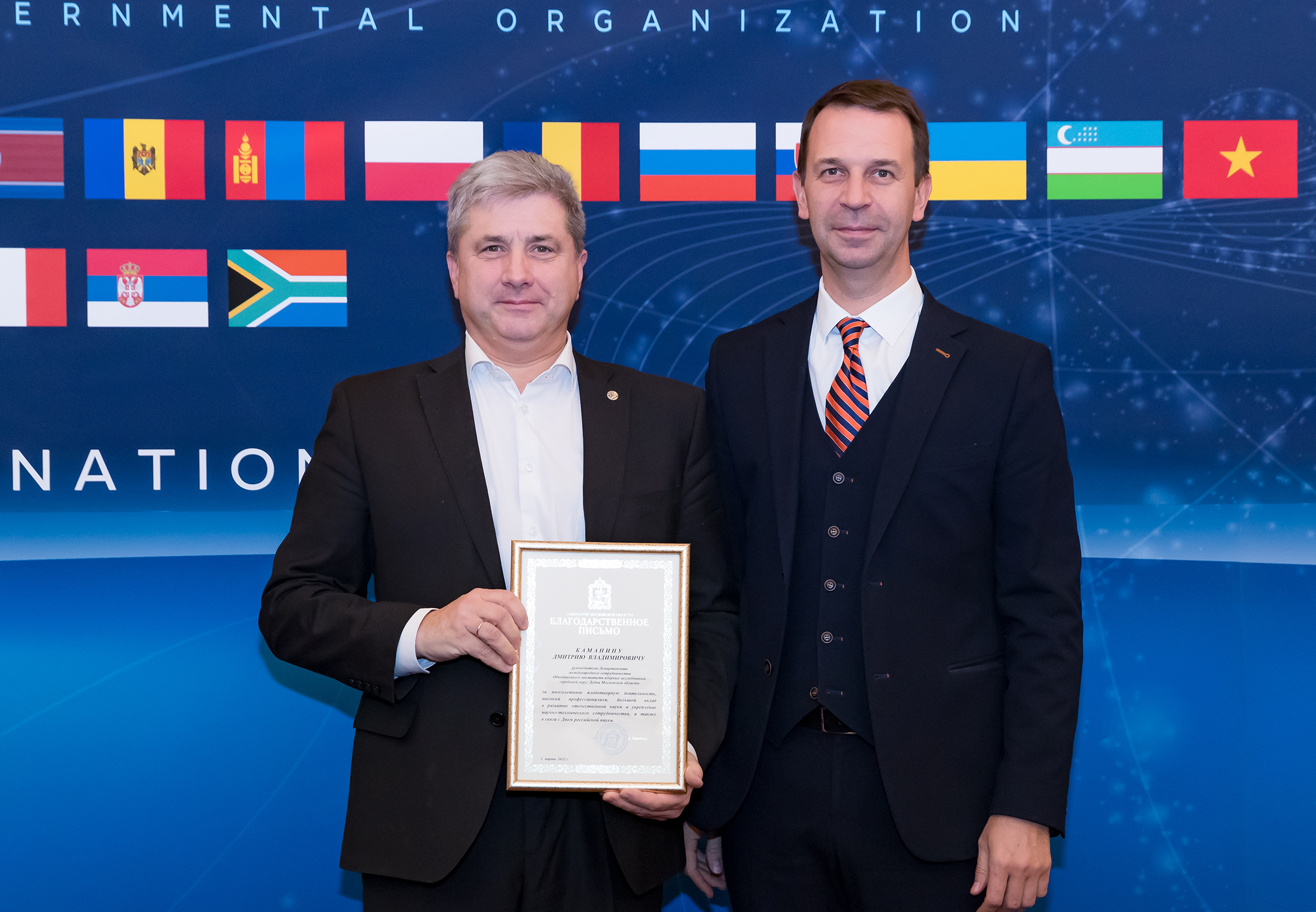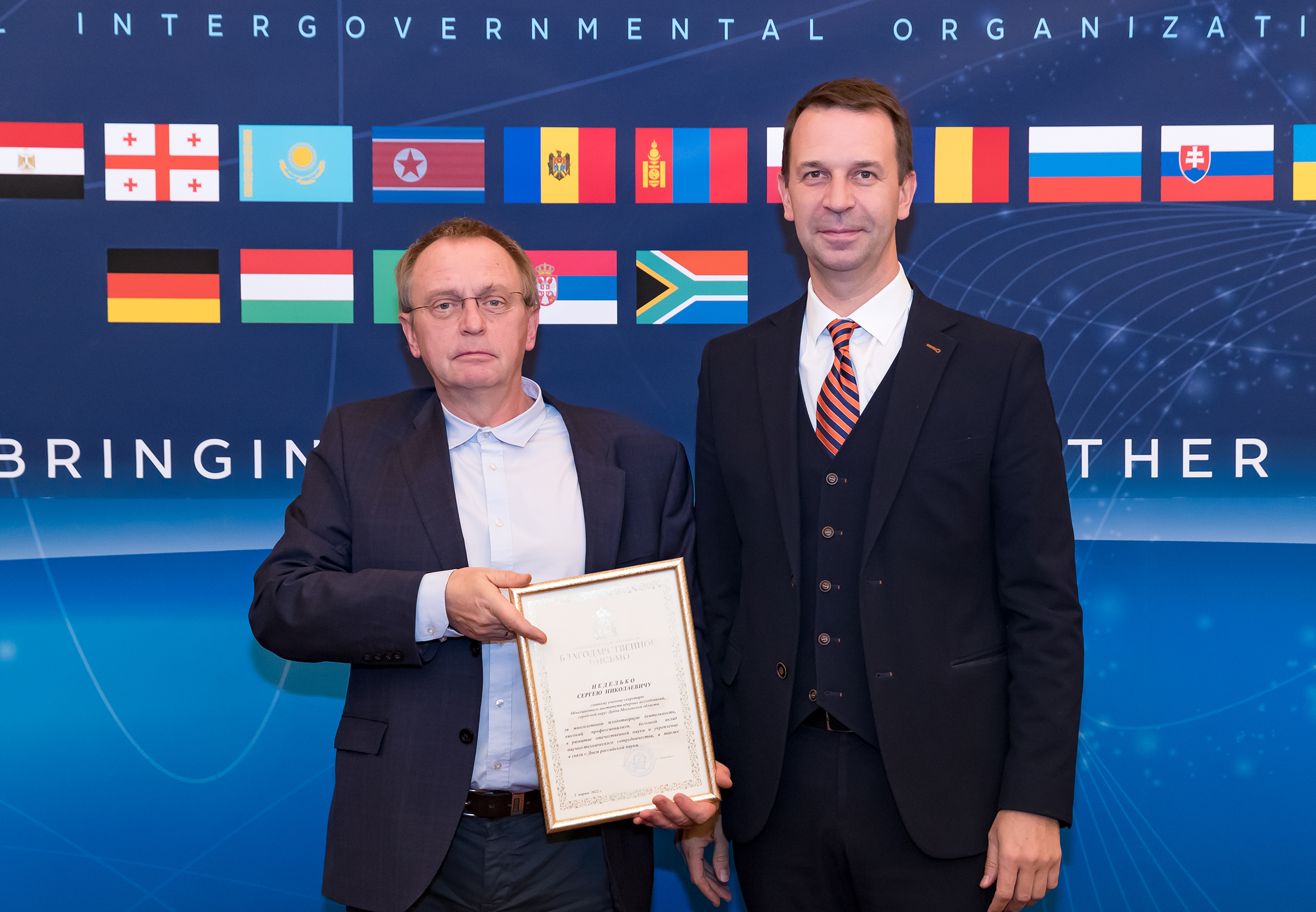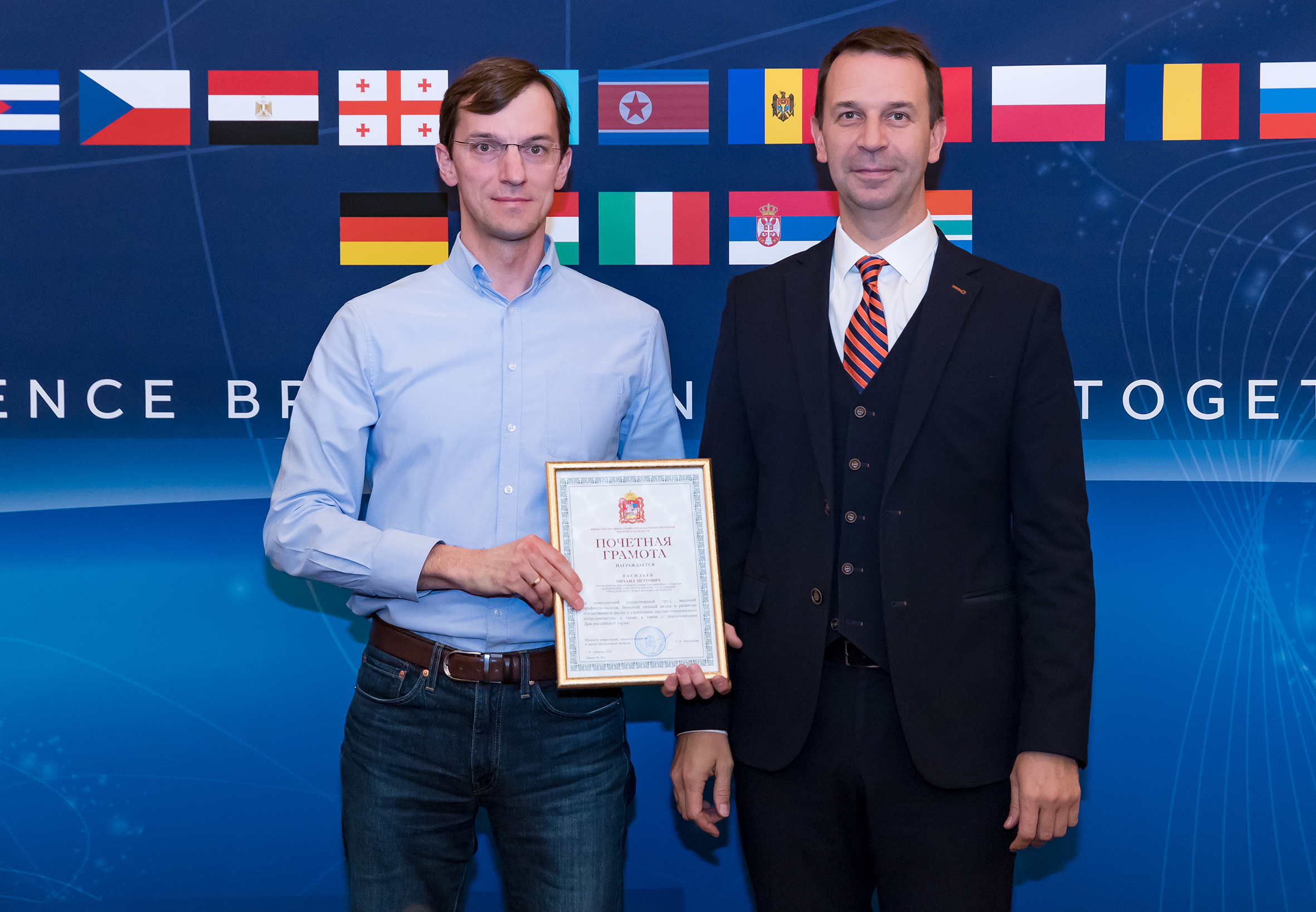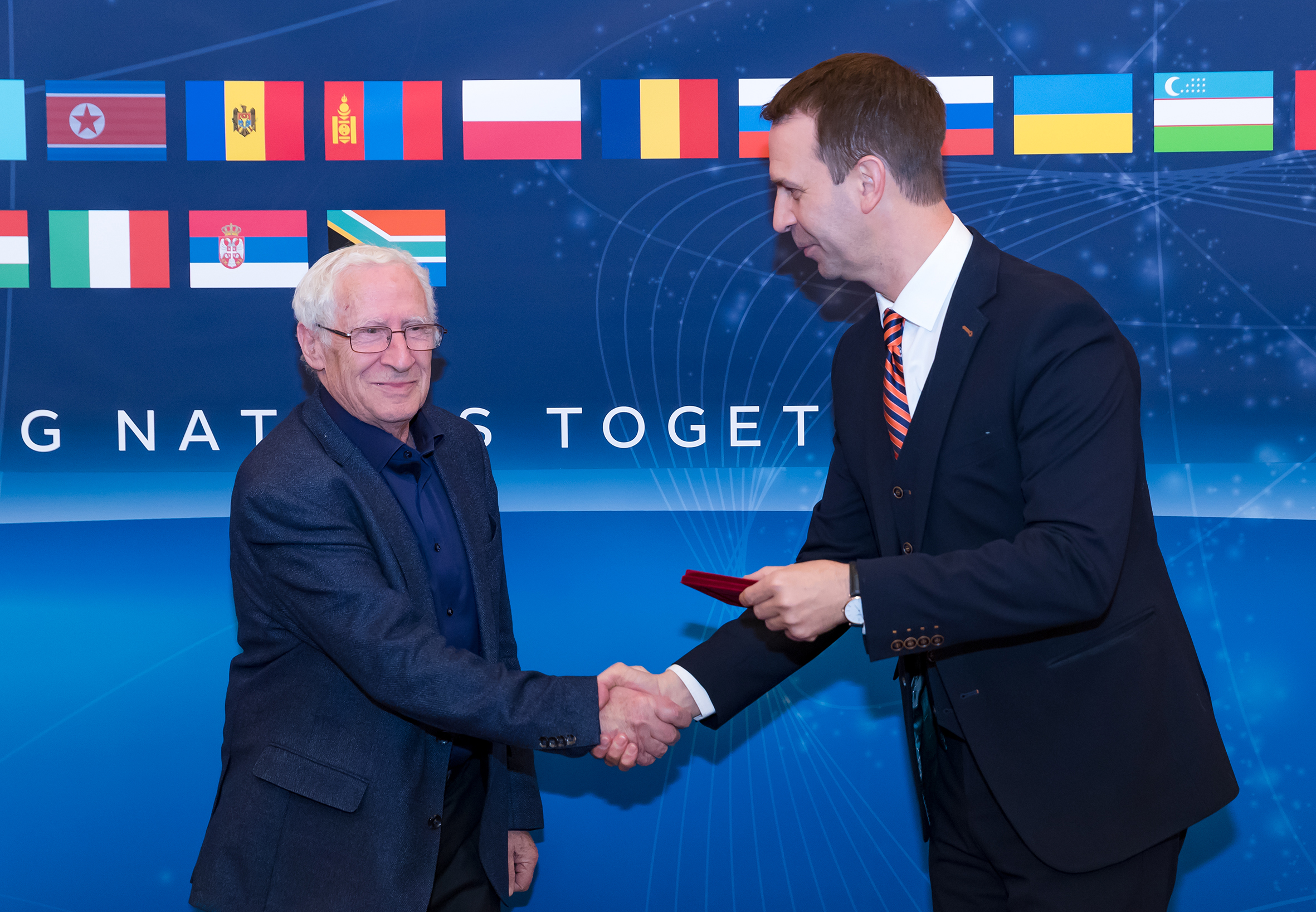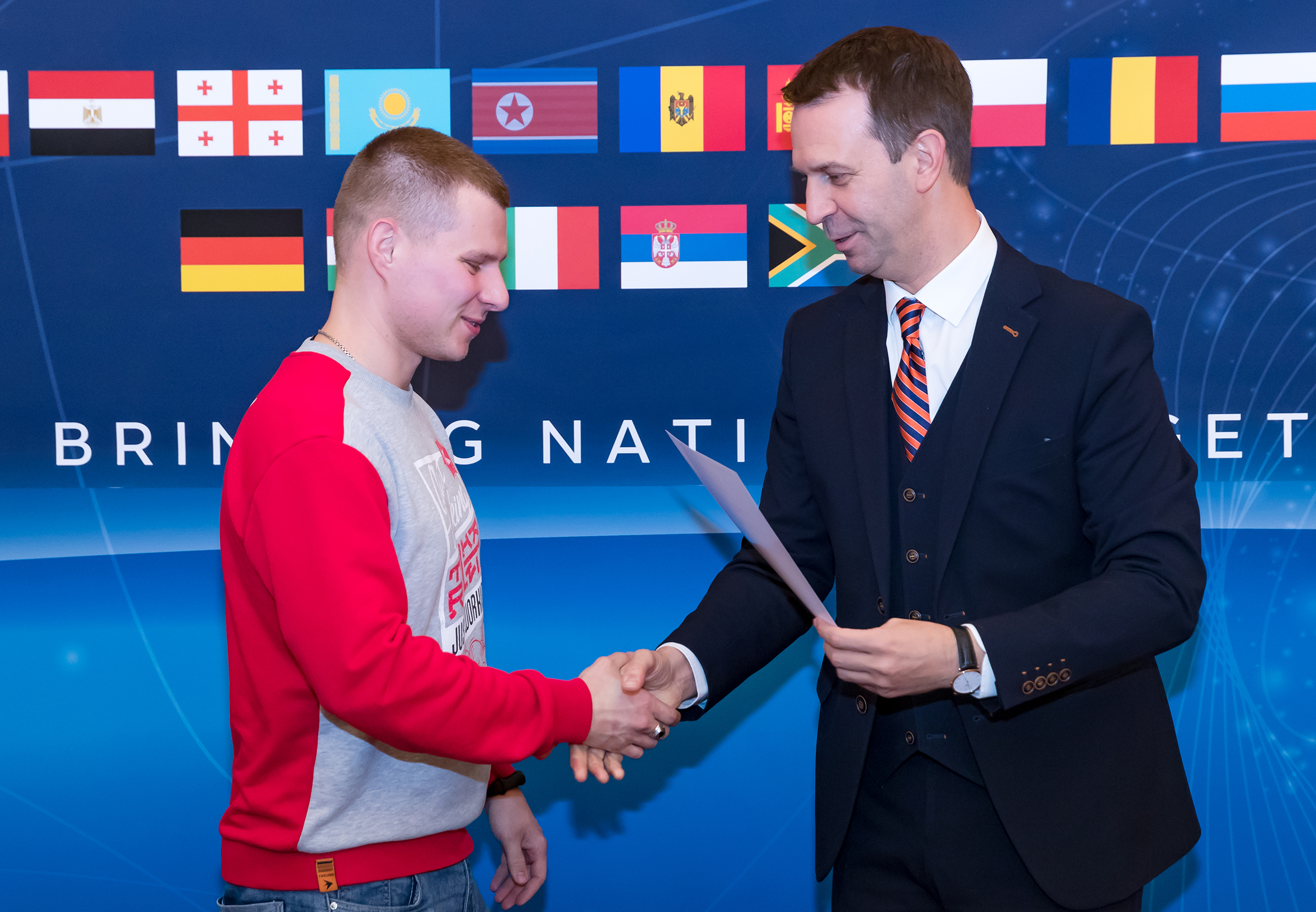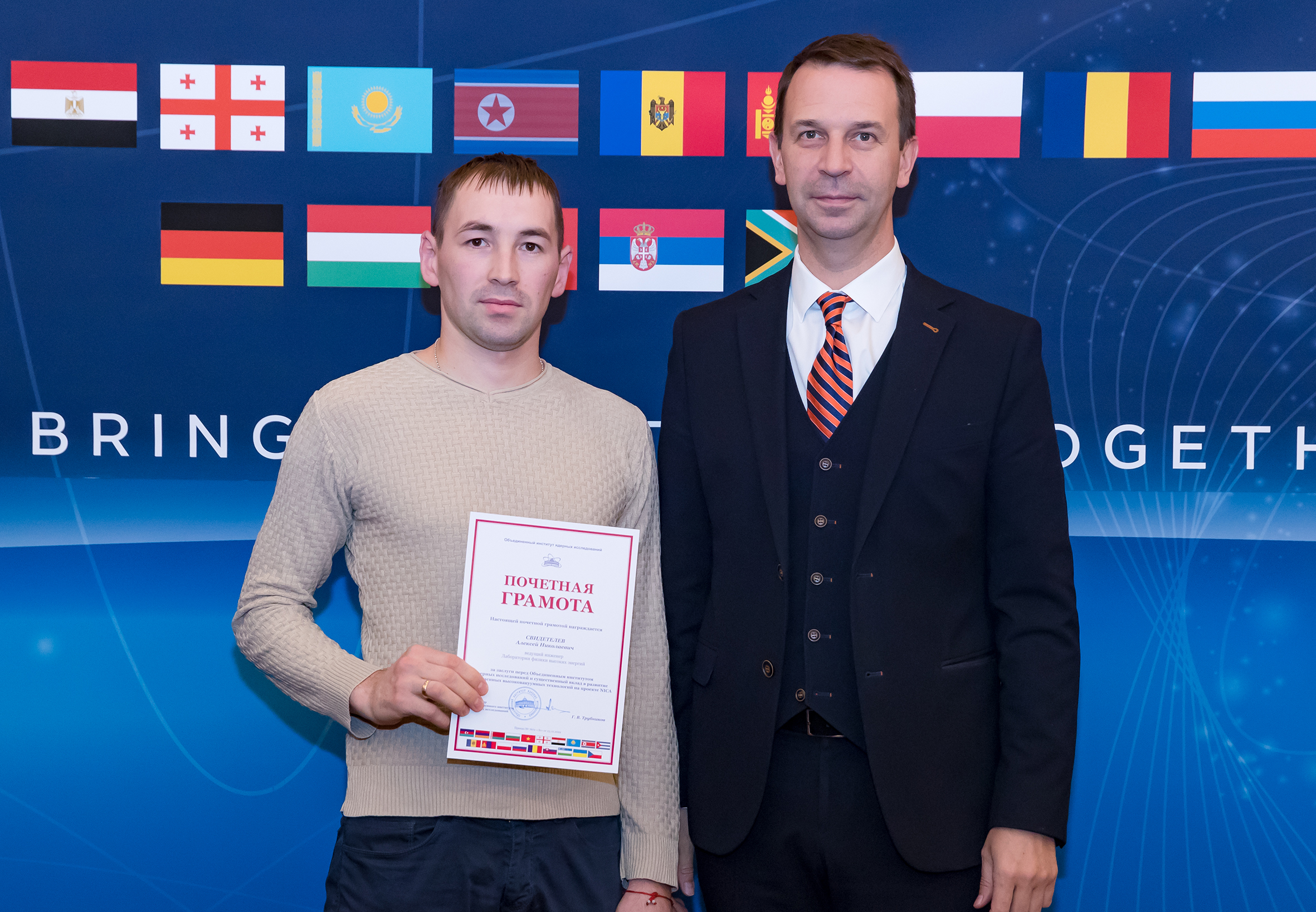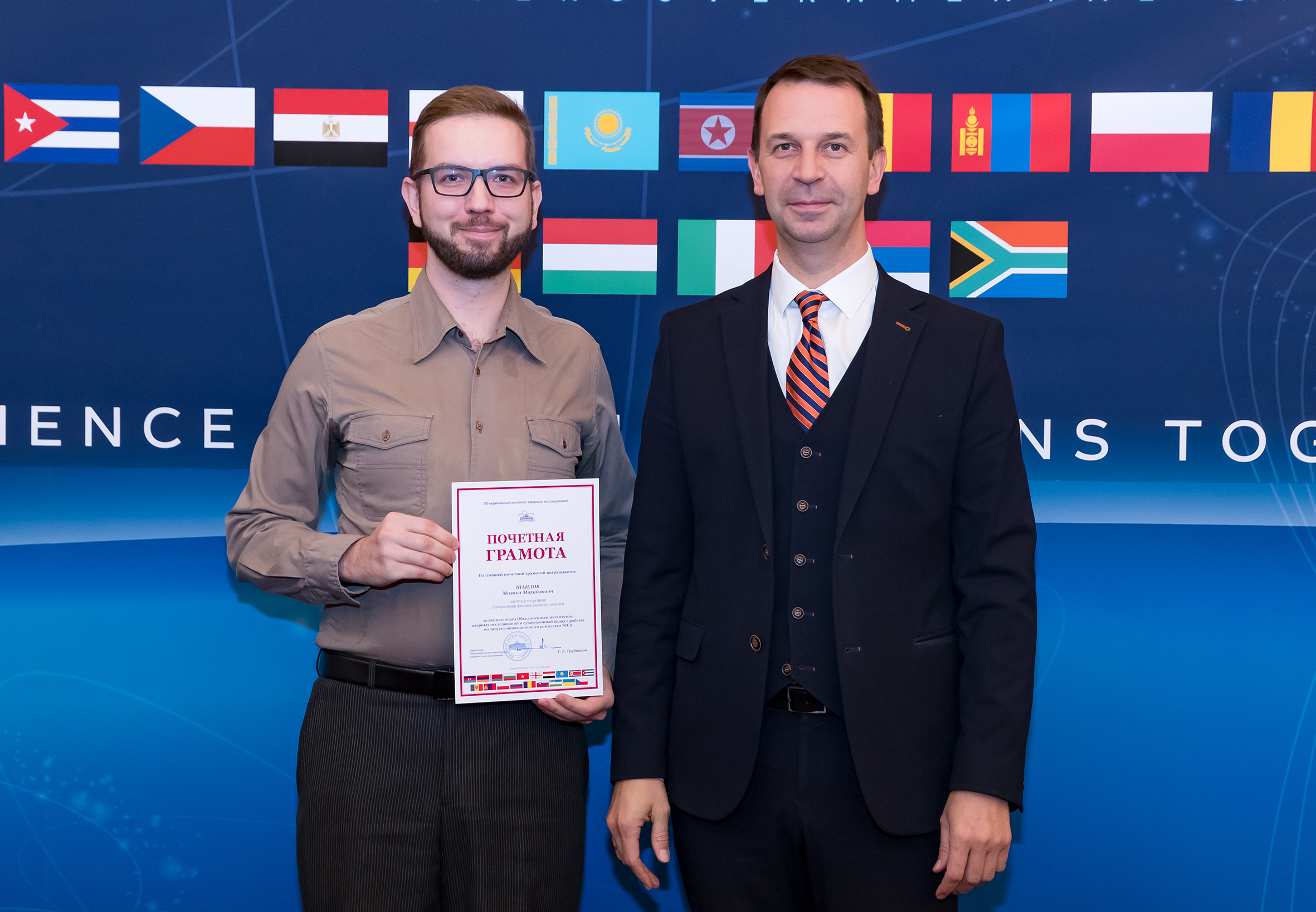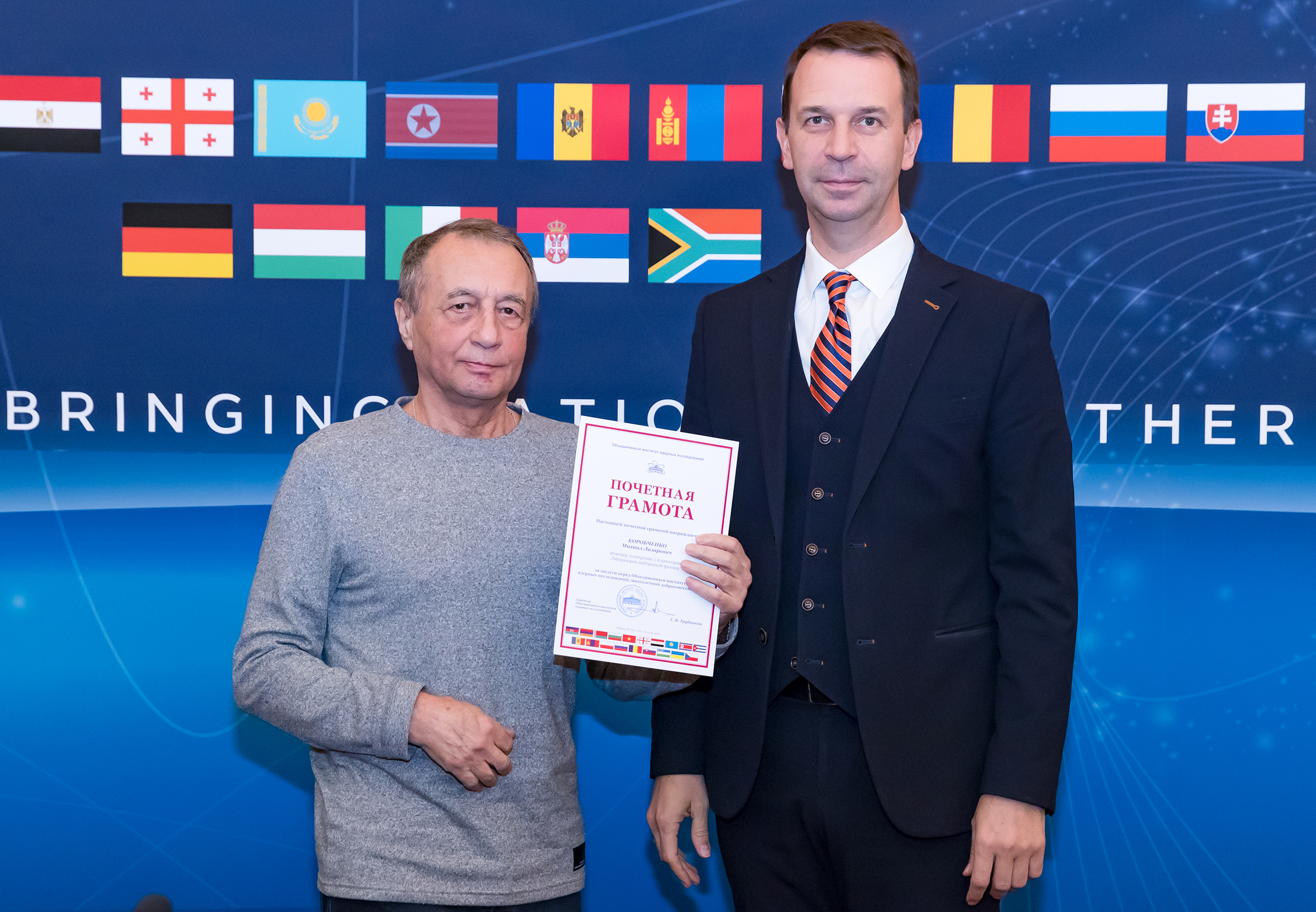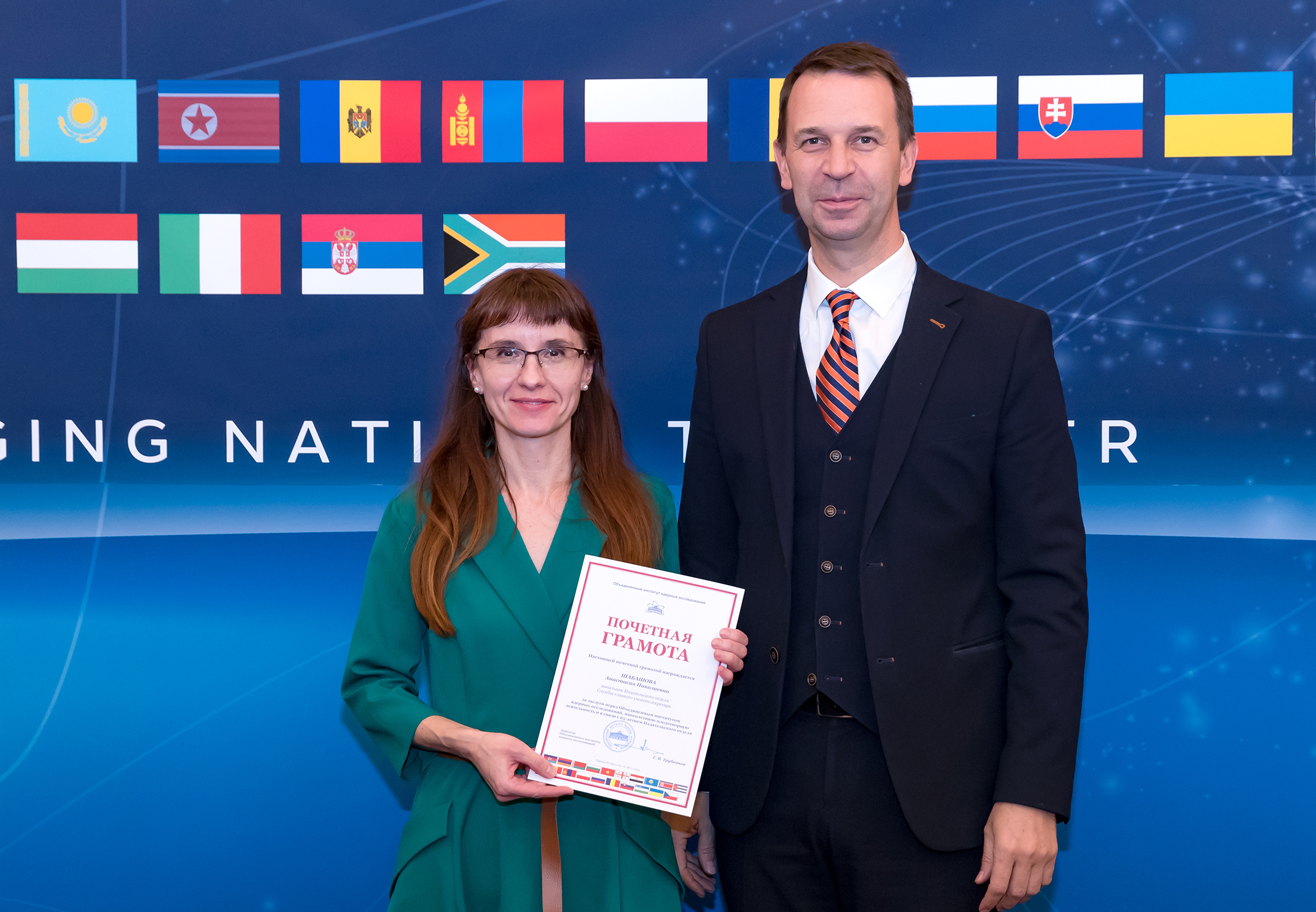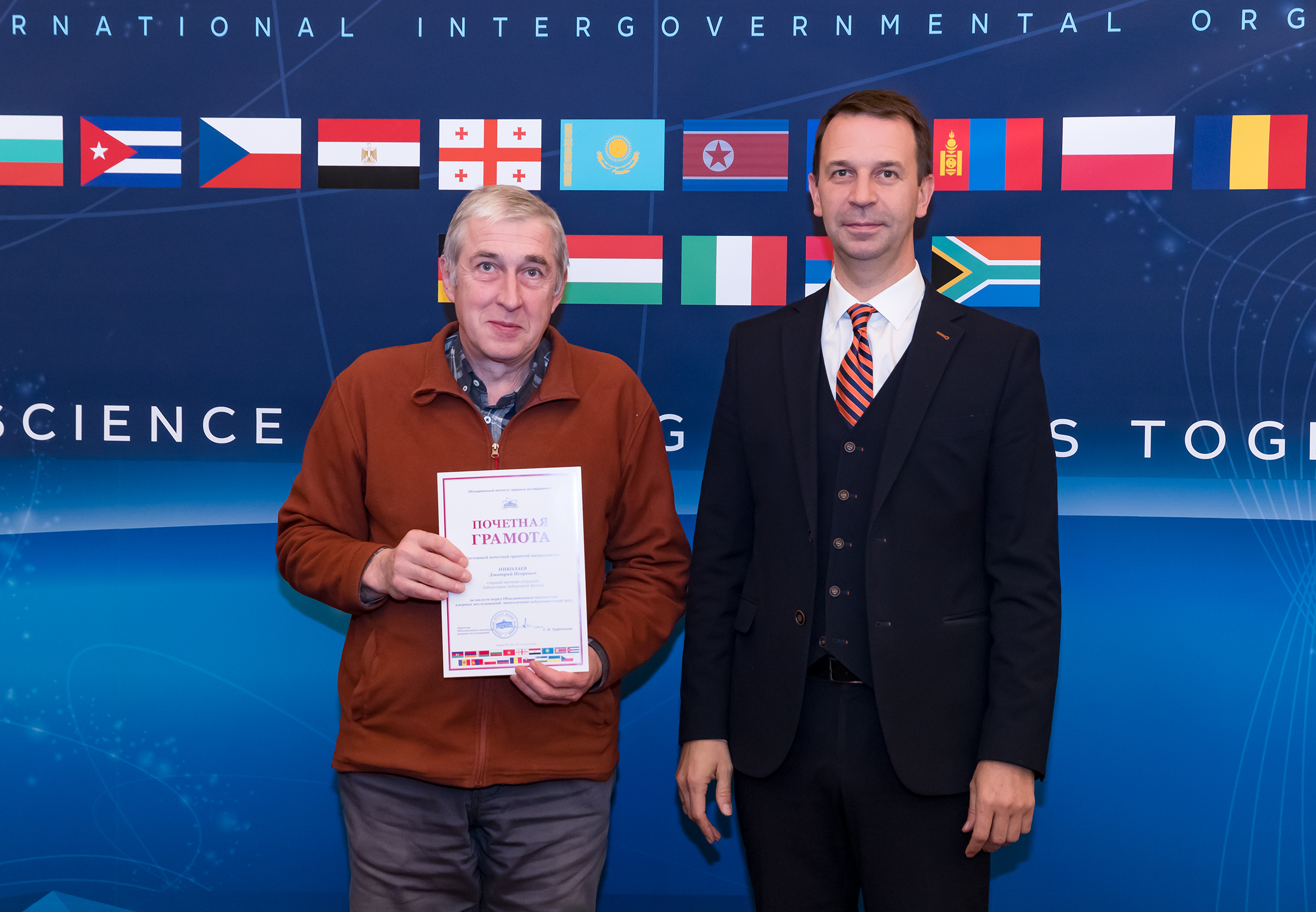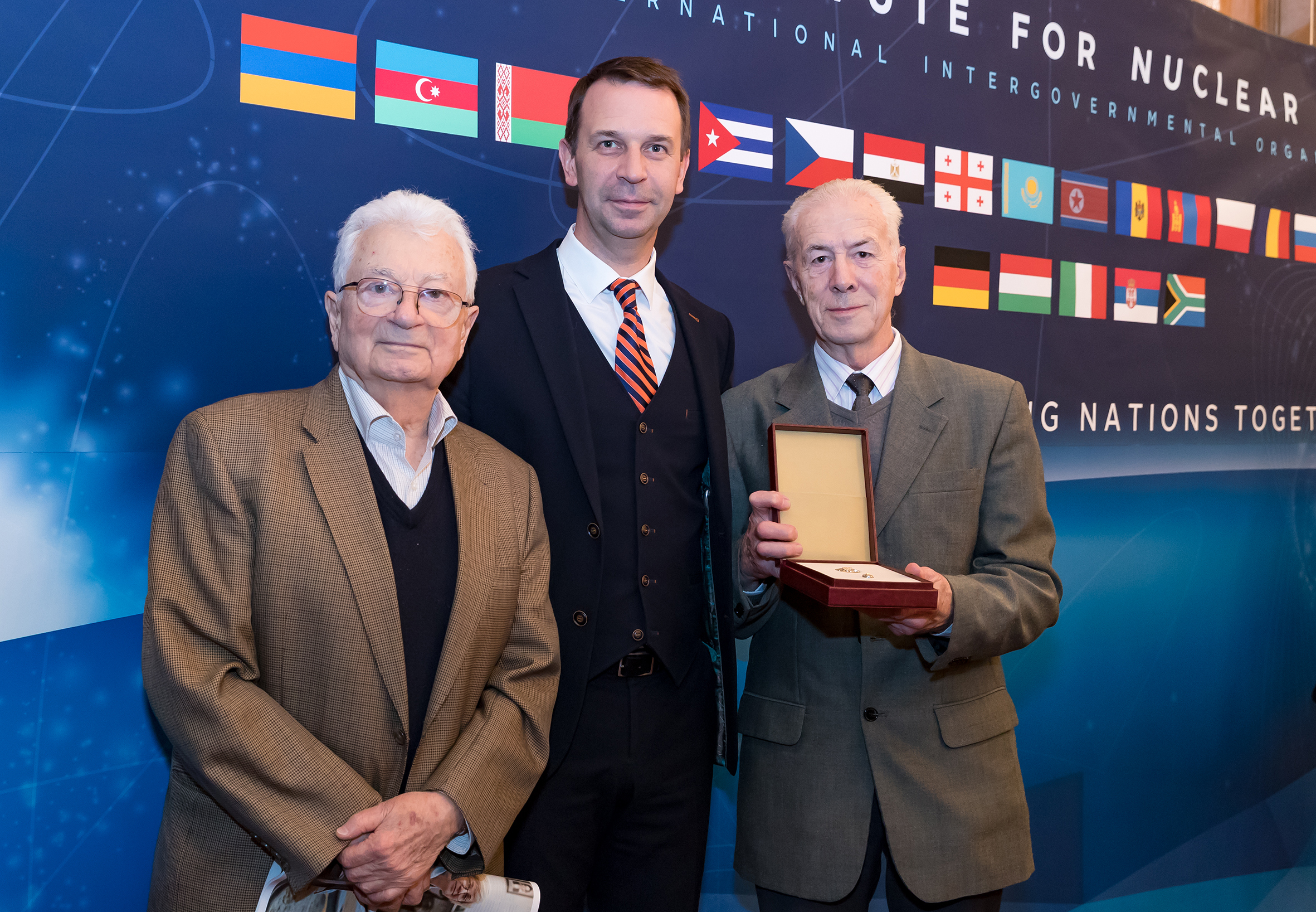At STC meeting: results of year and new plans
News, 26 December 2022
On 23 December, the last meeting of the JINR Science and Technology Council was held in the JINR International Conference Centre in a mixed format. Chairman of the Council Rostislav Jolos opened it. The subject matter of the meeting is general information about the JINR activity during 2022.
Director of the Institute, RAS Academician Grigory Trubnikov began his speech with the results of the Finance Committee and the Committee of Plenipotentiaries of the Governments of the JINR Member States sessions, which took place on 23 – 24 November in Egypt. A draft of a new Seven–Year Plan for 2024 – 2030 was adopted, Regulation for grants and programmes of Plenipotentiaries, JINR Postdocs, JINR Fellowship programmes aimed at attracting scientific youth from all over the world to JINR, strengthening the status of JINR as an international organization were endorsed. JINR activity in 2022 and scientific results achieved were highly appreciated. Information about the withdrawal of Poland, Ukraine and the Czech Republic from JINR was taken into account. The membership of Slovakia has been suspended.
“We respect the opinions and positions of the governments of Poland, the Czech Republic, Ukraine – the governments of the Member States of the Institute,” the speaker noted. “We are very sorry about this decision, because Poland, the Czech Republic, and Ukraine have made a huge contribution to the development of our Institute, to the achievements of JINR for many decades: intellectual, material, and personnel. These countries, their scientific organizations, and the names of outstanding scientists, specialists, and engineers are forever inscribed in the history of our Institute. It is impossible to forget and impossible to erase from memory. We are grateful to our colleagues from Poland, Ukraine and the Czech Republic, to organizers of science from these countries for their contribution, and I am sure that we will have human and scientific connections. And we will continue to do basic science together in international centres and international projects. We hope that circumstances will soon develop, which will lead to the resumption of thorough fully-fledged cooperation. The staff members of the Institute will be happy about that. I am sure that all our countries will benefit from this.”
Then the Director characterised new approaches to the formation and updating of the structure of Topical Plans, new structure of planning and expenditures of the JINR budget. This work will begin in 2023 and will be finished in 2024.
The scientific part of the report, which included the latest results obtained in the main areas of the Institute’s research activities, included relativistic nuclear physics and particle physics. It contained the beam extraction of xenon nuclei to the BM@N facility with record luminosity, measurement of the photoproduction cross-section of vector mesons in Pb-Pb and Xe-Xe collisions at LHC energies at the ALICE Facility, search for dark matter in the CMS experiment and dark photon in the NA64 experiment. The speaker highly appreciated these and other results achieved both in home and field projects extremely highly.
Works on modernisation of the supercomputer Govorun were highly praised. Computing field grew to 32 hyper-converged computing nodes, hierarchichal storage grew by 8 distributed storage nodes. These and other works performed by MLIT employees, along with methods, algorithms, and software for physical systems modelling, mathematical processing, and analysis of experimental data, provided the Institute with leadership in this field both in Russia and in other Member States.
Within 11 months in 2022, the Superheavy Element Factory provided 5400 hours of work for experiments on the synthesis and study of the properties of SHE. The first experiments on the chemistry of superheavy elements have been started. A new GRAND separator was launched; a chemical facility, including a cryodetector, was prepared; a series of test experiments were conducted to determine the effectiveness and optimal parameters of the facility; an experiment on the chemistry of elements 114 and 112 was started.
In the course of experiments on animals, the LRB staff members together with colleagues from the A. TSyb Medical Radiological Research Centre (Obninsk) proved and patented a fundamentally new method of selective destruction of tumor stem cells. After a standard radiation therapy, a radioresistant stem cell population usually survives and then generates new tumor cells. In the course of research, it was revealed that when using the method of enhancing the radiosensitivity of tumor cells previously discovered at LRB JINR using DNA synthesis inhibitors, death of most of the population of tumor stem cells is observed after one fraction of irradiation. When irradiated with protons, this mechanism works more effectively than when irradiated with photon beams.
At the Laboratory of Neutron Physics, the mechanisms of the process of crystallisation of membrane proteins in meso have been studied in detail for the first time, which makes it possible to create empirical foundations for the use of this type of crystallisation in rational medicine design. For the first time, the efficiency reflector of very cold neutrons (VCN) based on nanodiamond powder to increase the fluxes extracted from the source has been experimentally demonstrated.
International centres for collective use are actively developing at the laboratories of neutron physics and radiation biology. It is very important to increase the volume and efficiency of using this unique infrastructure for the development of scientific research in the interests of all the JINR Member States in cooperation with partner organizations in different countries of the world in the coming years. The entire JINR scientific infrastructure should become an open platform for scientists, engineers, and specialists from all over the world.
For the first time, after IceCube, the presence of an isotropic neutrino flux of astrophysical nature was confirmed according to the Baikal-GVD data. Data from 2018-2021 was used. The data set used was 4928 days of live time per cluster (configuration from 3 to 8 clusters).
Further, the report contained information on the results of the work of the University Centre, including the MSU, MIPT, MEPhI, KFU, SPBU, Dubna University-based departments and other. It also consisted of results of student programmes in 2022, on work with schoolchildren – environmental research lessons of the Educational Centre Sirius, online lectures, and excursions for the JINR Information Centres. It is planned to place a physics workshop, a school nuclear physics laboratory, robotics, classrooms, social communications group, a scientific and engineering group at the new additional building for UC in Vavilov street, 4A, which is currently undergoing repair work. A separate place in the report was occupied by the MSU branch in Dubna, which took over the baton from existing SINP MSU Department and two departments of the Faculty of Physics of MSU.
The infrastructure part of the report included the work of the services of the chief engineer: updating the structure of the Chief Power Engineer Department, work on new facilities, economic maintenance, and support for the activities of JINR departments, social sphere of the Institute. The report also included information about the activities of the Department for the Development of Digital Services, the current situation on the budget and the work of the accounting department, work with personnel, the legal department, the International Cooperation Department in 2022. The activities of the Information Centres, the JINR Press Office, the Department of Science Organization Activities, the JINR Dissertation Councils were highly appreciated.
Speaking about the active participation of the Institute in the Science and Technology Decade, the speaker noted that JINR had held and planned to hold several major scientific events: the joint JINR–CERN Student School in 2023, the NICA Collaboration meeting (2023), “Heavy Ion Physics: Low Energies and High Energies” – a joint forum organized by Armenia and Georgia (spring 2023). It is planned to participate in the UN special session dedicated to IYBSSD. “We are proud to be one of the international key partners of the Decade,” and we are grateful to IUPAP and IYBSSD/UNESCO,” Grigory Trubnikov noted.
“2022 will definitely be inscribed in the history of JINR,” the speaker stressed in conclusion. “The key to success is the results of the scientific programme, new opportunities, the pace of the development and sustainability of JINR. Scientific ties with Egypt, Serbia, Mexico, China are actively developing… Plans for 2023 are the start of commissioning of the NICA Complex, the start of construction of a new FLNR building, the active phase of creating a new MSC-230 accelerator; the adoption of a new Seven–Year Plan, the arrival of the next generation of directors at FLNP, MLIT, DLNP, VBLHEP, the inclusion of new members of the Scientific Council in the agenda”.
Rostislav Jolos, Vladimir Kekelidze, Vladimir Ladygin, Igor Meshkov, Boris Sharkov took part in the discussion of the report.
STC JINR unanimously supported the nomination of Alexander Shikanov (NRNU MEPhI) for the honorary title “Honoured Scientist of the Russian Federation”.
Awards were presented to employees of the Institute at the end of the STC meeting.
For many years of fruitful activity, high professionalism, a great contribution to the development of science and the strengthening of scientific and technical cooperation, Rostislav Jolos, chief researcher at BLTP, was awarded the honorary title “Honoured Scientist of the Moscow Region”.
Commendation from the Governor of the Moscow Region received:
- Vadim Bednyakov – Director of DLNP;
- Andrey Butenko – Acting Director of VBLHEP;
- Dmitri Kazakov – Director of BLTP.
A note of acknowledgement of the Governor of the Moscow region received:
- Dmitry Kamanin – Head of the International Cooperation Department;
- Sergey Nedelko – Chief Scientific Secretary of the Intitute.
A Certificate of Honour of the Ministry of Investment, Industry, and Science of the Moscow region received:
- Mikhail Vasiliev – Head of the Digital Services Development Department;
- Alexander Ruzaev – Assistant Director for Human Resources of the Institute.
For many years of conscientious work, significant achievements in professional activity, great personal contribution to the development of the nuclear industry, Mikhail Itkis, Deputy Scientific Leader of FLNR, was awarded the badge of Honour “For International Nuclear Power Cooperation”.
Certificates of honour of JINR received:
- for a significant contribution to the creation of vacuum and magnetic cryostat systems of the NICA Complex – chief engineer of VBLHEP Alexey Peltikhin;
- for a significant contribution to the development of modern high–vacuum technologies at the NICA Project – leading engineer of VBLHEP Alexey Svidetelev;
- for a significant contribution to the work on the launch of the NICA injection complex – researcher of VBLHEP Mikhail Shandov;
- For Merit to the Institute, many years of conscientious work: – Anastasia Shabashova – Head of the Publishing Department;
– Mikhail Korobchenko – electronic engineer of the 1s category of FLNP;
– Dmitry Nikolaev – senior researcher of FLNP
